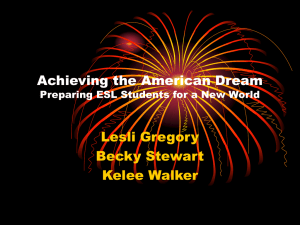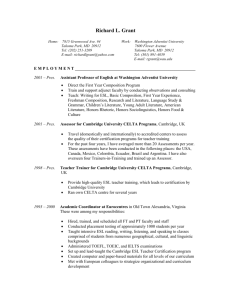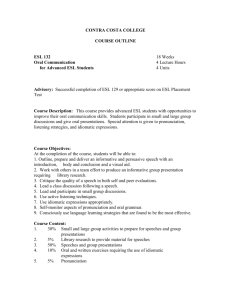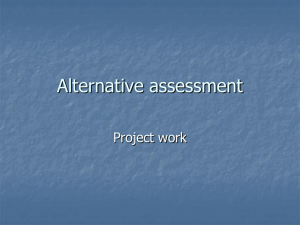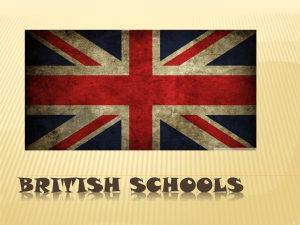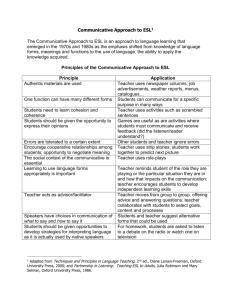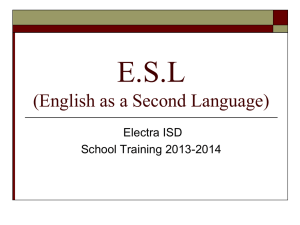English 469/G Dr. Ronald Eckard
advertisement
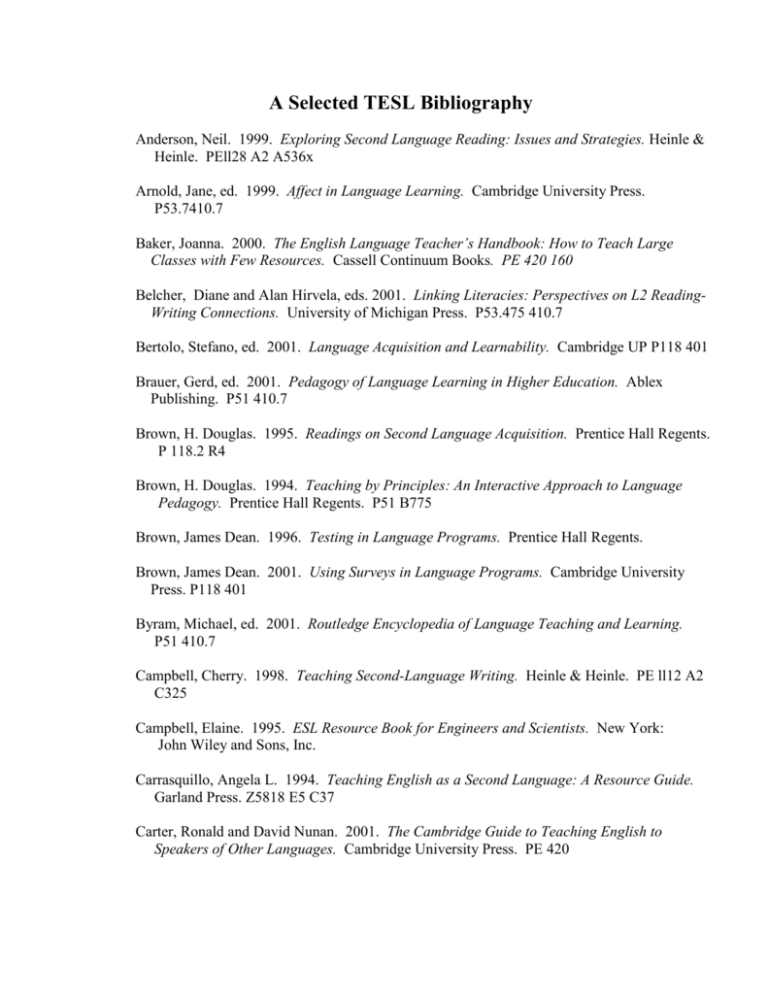
A Selected TESL Bibliography Anderson, Neil. 1999. Exploring Second Language Reading: Issues and Strategies. Heinle & Heinle. PEll28 A2 A536x Arnold, Jane, ed. 1999. Affect in Language Learning. Cambridge University Press. P53.7410.7 Baker, Joanna. 2000. The English Language Teacher’s Handbook: How to Teach Large Classes with Few Resources. Cassell Continuum Books. PE 420 160 Belcher, Diane and Alan Hirvela, eds. 2001. Linking Literacies: Perspectives on L2 ReadingWriting Connections. University of Michigan Press. P53.475 410.7 Bertolo, Stefano, ed. 2001. Language Acquisition and Learnability. Cambridge UP P118 401 Brauer, Gerd, ed. 2001. Pedagogy of Language Learning in Higher Education. Ablex Publishing. P51 410.7 Brown, H. Douglas. 1995. Readings on Second Language Acquisition. Prentice Hall Regents. P 118.2 R4 Brown, H. Douglas. 1994. Teaching by Principles: An Interactive Approach to Language Pedagogy. Prentice Hall Regents. P51 B775 Brown, James Dean. 1996. Testing in Language Programs. Prentice Hall Regents. Brown, James Dean. 2001. Using Surveys in Language Programs. Cambridge University Press. P118 401 Byram, Michael, ed. 2001. Routledge Encyclopedia of Language Teaching and Learning. P51 410.7 Campbell, Cherry. 1998. Teaching Second-Language Writing. Heinle & Heinle. PE ll12 A2 C325 Campbell, Elaine. 1995. ESL Resource Book for Engineers and Scientists. New York: John Wiley and Sons, Inc. Carrasquillo, Angela L. 1994. Teaching English as a Second Language: A Resource Guide. Garland Press. Z5818 E5 C37 Carter, Ronald and David Nunan. 2001. The Cambridge Guide to Teaching English to Speakers of Other Languages. Cambridge University Press. PE 420 Center for Language Training. 1998. Storytelling: A Cultrual Bridge. XVR 0443 Ed Center Kit Room Celce-Murcia, Marianne. 2000. Discourse and Context in Language Teaching: A Guide for Language Teachers. Cambridge University Press. P53 410.7 Celce-Murcia, Marianne. 2001. Teaching English as a Second or Foreign Language. Heinle and Heinle. PE 1128 428 Chastain, Kenneth. 1986. Developing Second-Language Skills, 3rd ed. Rand McNally. PB35 C532 Chaudron, Craig. 1988. Second language Classrooms: Research on Teaching and Learning. CUP. P53 C43 Clayton, Jacklyn Blake. 1995. Your Land, My Land: Children in the Process of Acculturation. Heinemann. Clegg, John, ed. 1996. Mainstreaming ESL. Multilingual Matters. PE 1128 A2 M315 Cook, Vivian. 2001. Second Language Learning and Language Teaching, 3rd ed. Oxford University Press. P 417 Crandall, Joann. 1993. Approaches to Adult ESL Literacy Instruction. CAL. PE 1128 A2 A53 Diaz-Rico, Lynne T. 1996. The Crosscultural Language and Academic Development Handbook. Allyn and Bacon. PE 1128 A2 D45 Echevarria, Jana. 2000. Making Content Comprehensible for English Language Learners. Allyn and Bacon. PE 1128 A2 E24 2000 Echevarria, Jana and Anne Graves. 1998. Sheltered Content Instruction: Teaching English Language Learners with Diverse Abilities. PE 1128 A2 E26 Edge, Julian. 1993. Essentials of English Language Teaching. Longman. PE 1128 A2 E275 Ellis, Rod. 1994. The Study of Second Language Acquisition. Oxford University Press. P 118.2 E4x Ferris, Dana and John Hedgcock. 1998. Sheltered Content Instruction: Teaching EnglishLanguage Learners with Deverse Abilities. PE1128 A2 E26 Freeman, David E. And Yvonne S. Freeman. 1994. Between Worlds: Access to Second Language Acquisition. Heinemann. P 118.2 F74 Freeman, David E. And Yvonne S. Freeman. 1998. ESL/EFL Teaching: Principles for Success. Heinemann. P53 F73 1998 Freeman, David E. And Yvonne S. Freeman. 2000. Teaching Reading in Multilingual Classrooms. Heinemann. LB 1050.2 F73x Ed. Center Fu, Danling. 1995. “My Trouble is My English”: Asian Students and the American Dream. Boynton/Cook. P1130 A2 F8 Gebhard, Jerry G. 1996. Teaching English as a Foreign or Second Language. University of Michigan Press. PE 1128 A2 G38 Hall, David R. And Ann Hewings, eds. 2001. Innovations in English Language Teaching: A Reader. Routledge. PE 1128 428 Hamilton, Judith. 1996. Inspiring Innovation in Language Teaching. Multilingual Matters. PB 35. H284 Harmer, Jeremy. 1998. How to Teach English: An Introduction to the Practice of English Language Teaching. Cambridge University Press. PE 1128 A2 H33x Hendrickson, Robert. 2001. World English: From Aloha to Zed. John Wiley. PE 2751 427 Higgins, John. 1995. Computers and English Language Learning. Ablex. P53.28 H544 Hinkel, Eli and Sandra Fotos, eds. 2002. New Perspectives on Grammar Teaching in Second Language Classrooms. Lawrence Erlhaum. P 53.412 410.7 Hurley, Sandra R. And Josefina V. Tinajero, eds. 2001. Literacy Assessment of Second Language Learners. Allyn and Bacon. P 53.4 410.7 Jacobs, Holly et al. 1981. Testing ESL Composition: A Practical Approach. PE1128 A2 T433 Kottler, Ellen. 1994. Children with Limited English: Teaching Strategies for the Regular Classroom. Corwin Press. PE 1128 A2 K68 Leki, Ilona. 1992. Understanding ESL Writers. Boynton/Cook. PE1128 A2 L385 Lewis, Marilyn. 1997. Journeys in Language Learning: ESOL Students in Elementary Classrooms Around the World. PE 1128 A2 L43x Littlewood, William. 1984. Foreign and Second Language Learning. CUP P53 L54 McKay, Sandra. 1987. Teaching Grammar. OUP. PE1128 A2 M4 Mendelsohn, David, ed. 1999. Expanding Our Vision: Insights for Language Teachers. Oxford University Press. PE 1128 A2 M515x Mlynarczyk, Rebecca. 1998. Conversations of the Mind: The Uses of Journal Writing for Second-Language Learners. PE 1128 A2 M554 Morgan, Brian. 1998. ESL Classrooms: Teaching, Critical Practice, Community Development. PE 1128 A2 MS595 Moskowitz, Gertrude. 1978. Caring and Sharing in the Foreign Language Class. Newbury House. P53 M66 Nunan, David and Lindsay Miller. 1995. New Ways in Teaching Listening. TESOL. PE1128 A2 N48x Nunan, David. 1999. Second Language Teaching and Learning. Boston: Heinle & Heinle. PE 420 Ovando, Carlos and Virginia Collier. 1998. Bilingual and ESL Classrooms: Teaching in Multicultural Contexts. McGraw-Hill. LC 3731 .096 Peregoy, Suzanne and Owen Boyle. 1997. Reading, Writing, and Learning in ESL: A Resource Book for K-12 Teachers. Longman. PE 1128 A2 P393 Phillips, Sarah. 1993. Young Learners. New York: Oxford University Press. PE1128 A2 P57 Reid, Joy M. 1993. Teaching ESL Writing. Prentice Hall. PE 1128 A2 R45 Reid, Joy M. 1998. Understanding Learning Styles in the Second Language Classroom. Prentice Hall Regents. PE 1128 A2 U52 Reid, Joy M. And Pat Byrd. 1998. Grammar in the Composition Classroom. Heinle and Heinle. PE 1128 A2 R448 Richards, Jack C. 2001. Curiculum Development in Language Teaching. Cambridge Univ. Press. P 53.295 410.7 Richards, Jack C. and Theodore Rodgers. 2001. Approaches and Methods in Language Teaching. Cambridge University Press. P51 410.7 Robinson, Julia and Mary Selman. 1996. Partnerships in Learning: Teaching ESL to Adults. Toronto: Pippin Publishing. Sauve, Virginia L. 2000. Voices and Visions: An Introduction to Teaching Adult ESL. Oxford University Press. PE 1128 A2 S286x Singleton, David. M. 1999. Exploring the Second Language Mental Lexicon. CUP. P1128.241 Smoke, Trudy, ed. 1998. Adult ESL: Politics, Pedagogy, and Participation in Classroom and Community Programs. PE 1128 A2 A326 Spratt, Mary. 1994. English for the Teachers: A Language Development Course. Cambridge University Press. PE 1128 A2 S67 Stevick, Earl. 1998. Working with Teaching Methods. Heinle and Heinle. PE 1128 A2 S83 Swan, Michael and Bernard Smith. 1987. Learner English. CUP. PE1128 A2 L36 Taylor, Erick. 2000. Using Folktales. Cambridge University Press. LB 1576. T34 Taylor, Linda. 1990. Teaching and Learning Vocabulary. Prentice Hall PE1128 A2 T35 Tomalin, Barry. 1994. Cultural Awareness. New York: Oxford University Press. Toohey, Kelleen. 2000. Learning English at School: Identity, Social Relations, and Classroom Practice. Clevedon. PE 1128 428 Tucker, Amy. 1995. Decoding ESL: International Students in the American Classroom. Boynton/Cook. PE68 200 F01 E5 White, Goodith. 1998. Listening. Oxford University Press. LB 1139. L5 W47x Vale, David and Anne Feunteun. 1995. Teaching Children English: A Training Course. Cambridge University Press. P 118.2 F74 GUIDE TO WRITING A BOOK REVIEW English 469/G Dr. Ronald Eckard Using traditional paragraphy style, write a book review that incorporates the following suggestions: 1. List the author(s), title, date of publication, and other bibliographic data for the book by using the following format: Michael Swan and Bernard Smith. 1987. Learner English: A Teacher’s Guide to Interference and Other Problems. New York: Cambridge University Press. 2. Do not plagiarize. If you copy something from the book (e.g., an important phrase, a sentence, a definition), use quotation marks and list the appropriate page numbers. For long quotations (three or more lines) use block quotations. 3. Identify the major purpose of the book. Is that purpose mentioned in the introduction to the book? Is that purpose important? Does the book fulfill that purpose? 4. What topics does the book cover in order to satisfy that purpose? 5. How well are the topics covered? Are some topics covered more thoroughly than others? 6. What are the strengths of the book? 7. What are its weaknesses? 8. What can be done to improve the book? 9. Are there any memorable quotations in the book? If so, list them and explain why they are meaningful. 10. Would you recommend this book? If so, to whom? ENGLISH 469 ESL CLASS OBSERVATION 1. Topic or focus of the lesson (review of irregular verbs, vocabulary development, etc.) 2. What was the proficiency level of the class (beginner, intermediate, advanced)? 3. What percentage of class time was devoted to each of the following: reading, writing, listening, speaking, grammar, culture, other? 4. What teaching method or methods were most frequently used by the teacher? 5. Comment on the use of class time for interaction, i.e., what percentage of time was the speaking teacher to student(s), student to teacher, student to student? 6. Comment on the effectiveness (or lack thereof) of the learning environment, the appropriateness of the physical classroom and the surroundings. 7. Comment on the psychological learning environment. Do students seem happy and eager to learn? Does the teacher establish an open and safe relationship with the students, one in which the students feel free to ask questions and to admit when they don’t understand. 8. What are the strengths of this lesson? 9. What are the weaknesses of this lesson? 10. What changes would you recommend in order to improve the teaching/learning?
